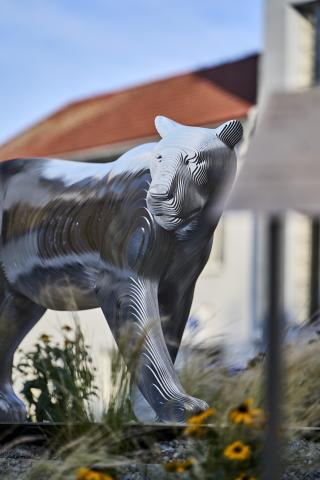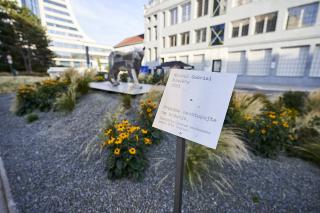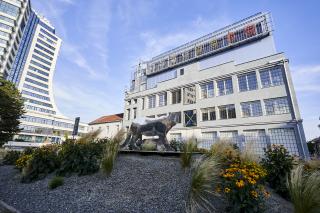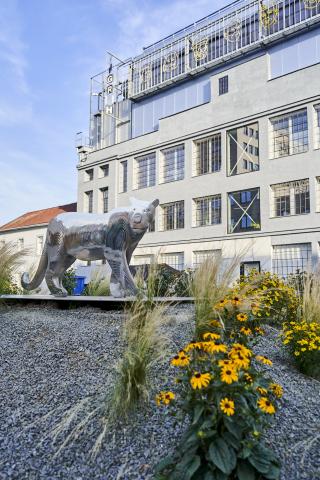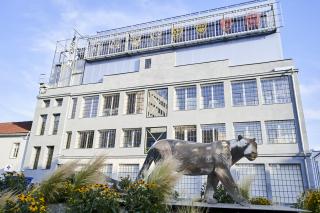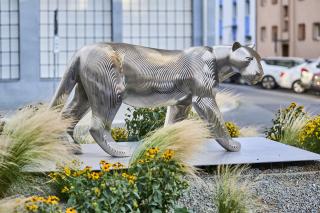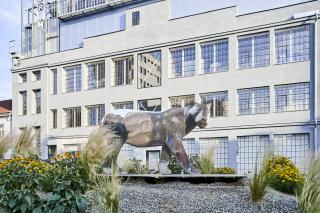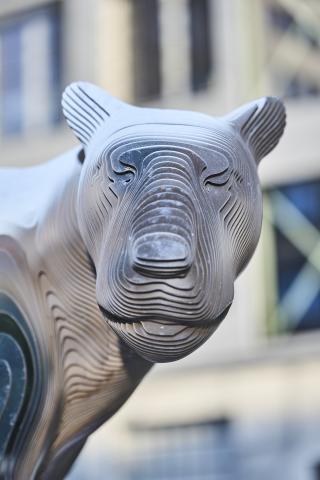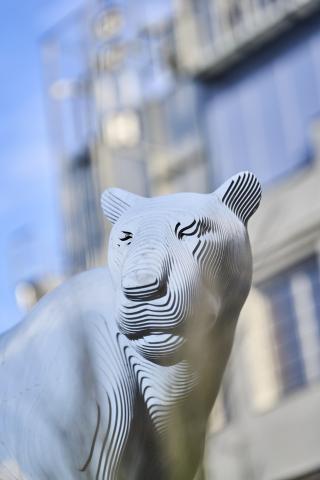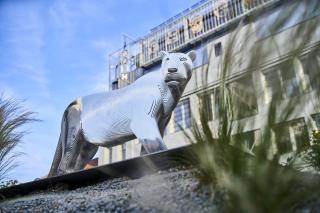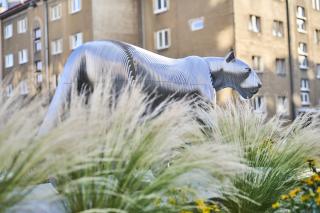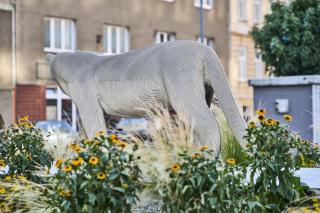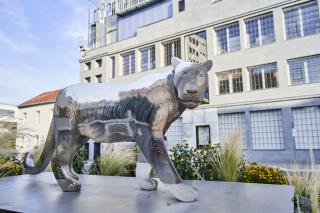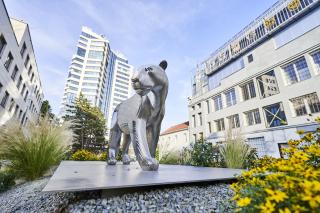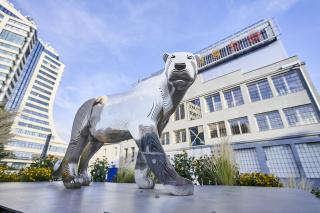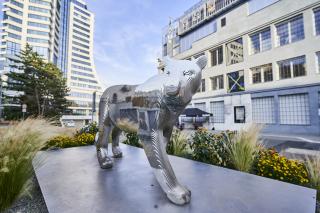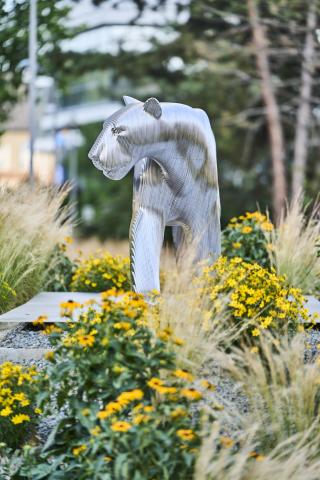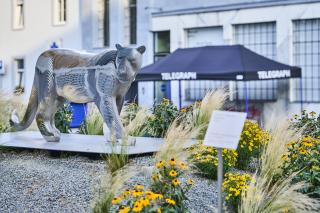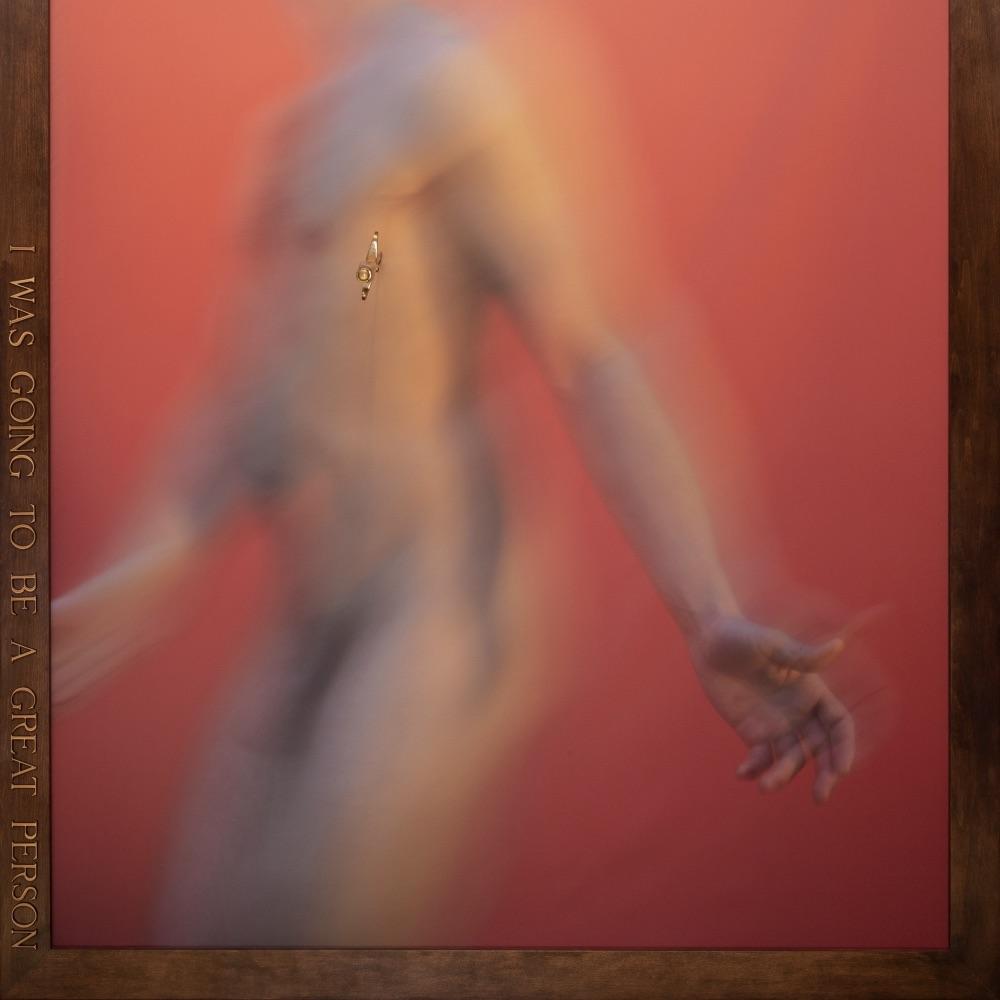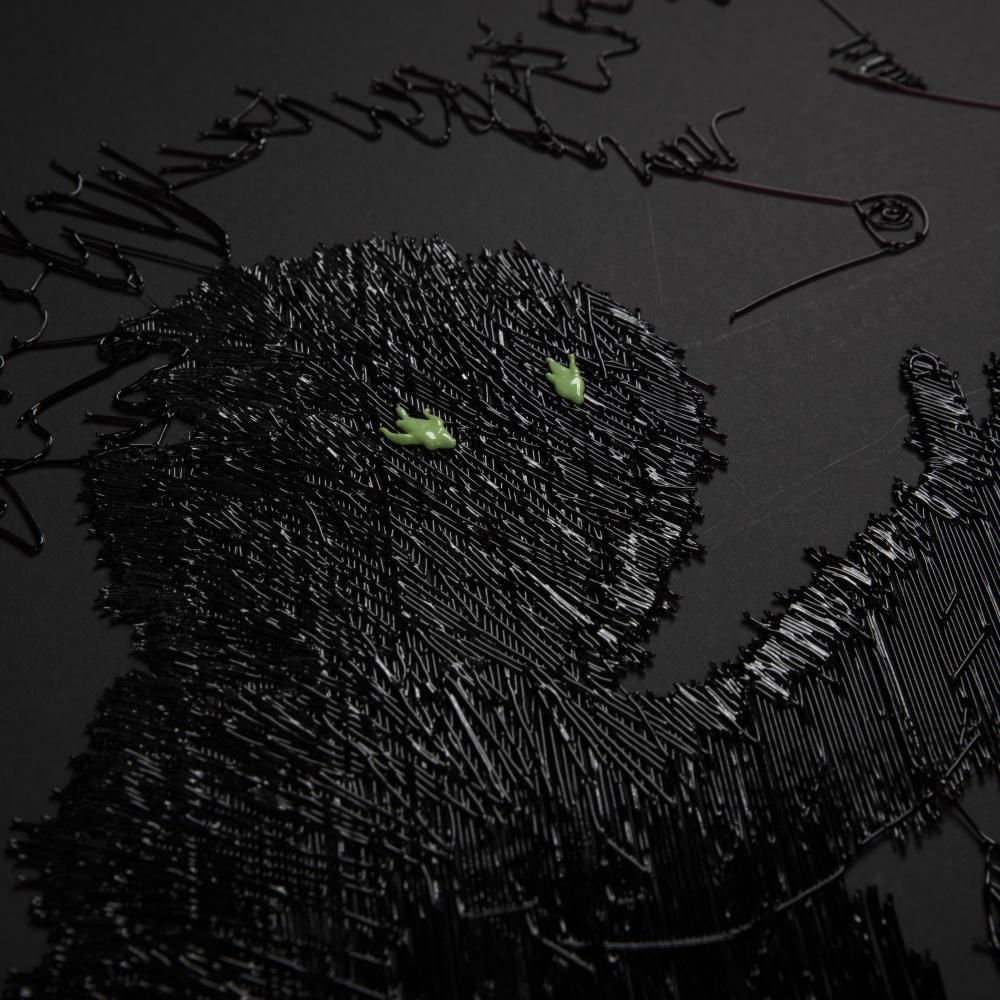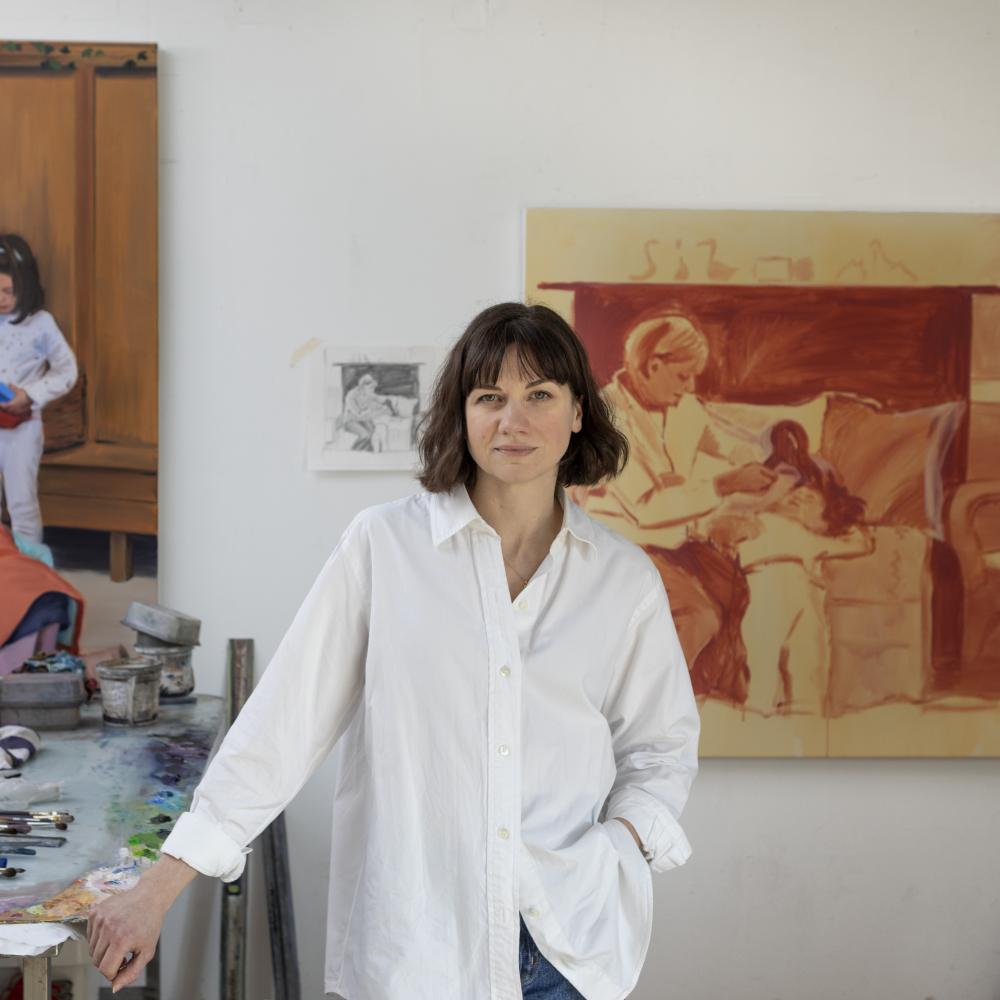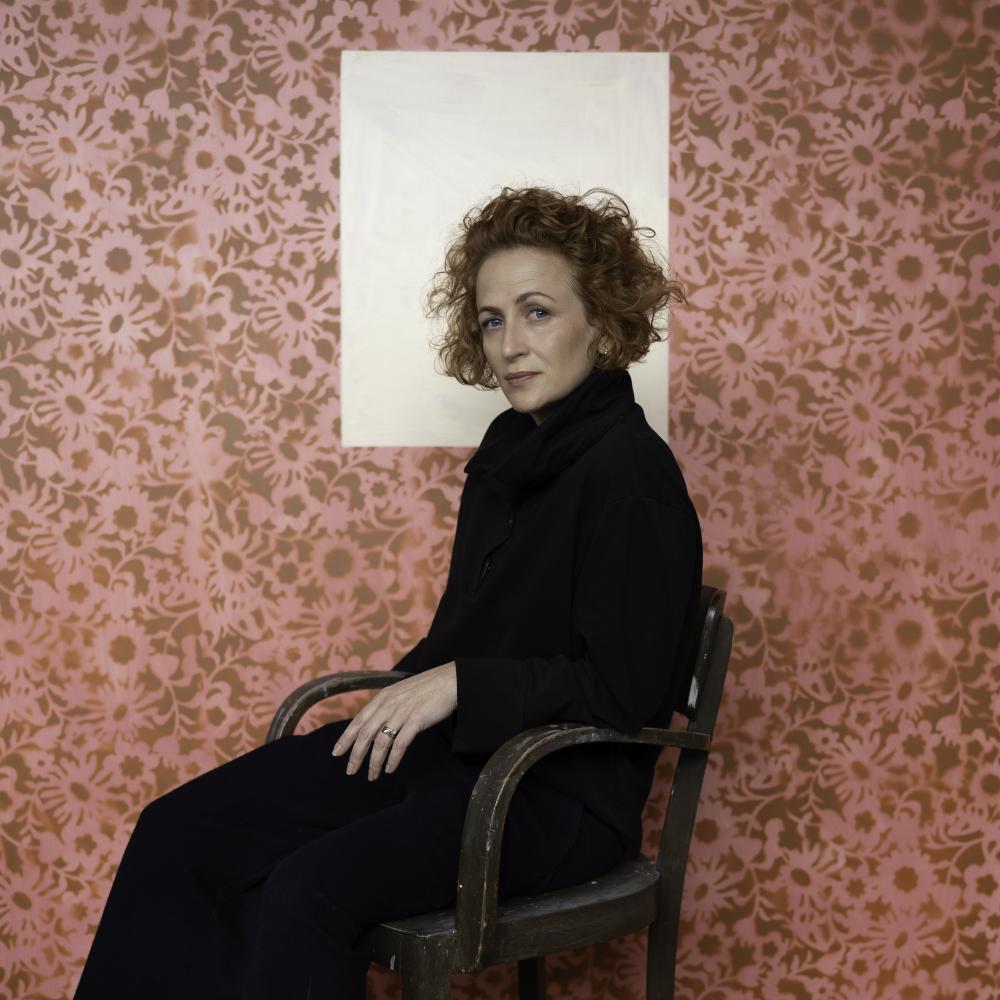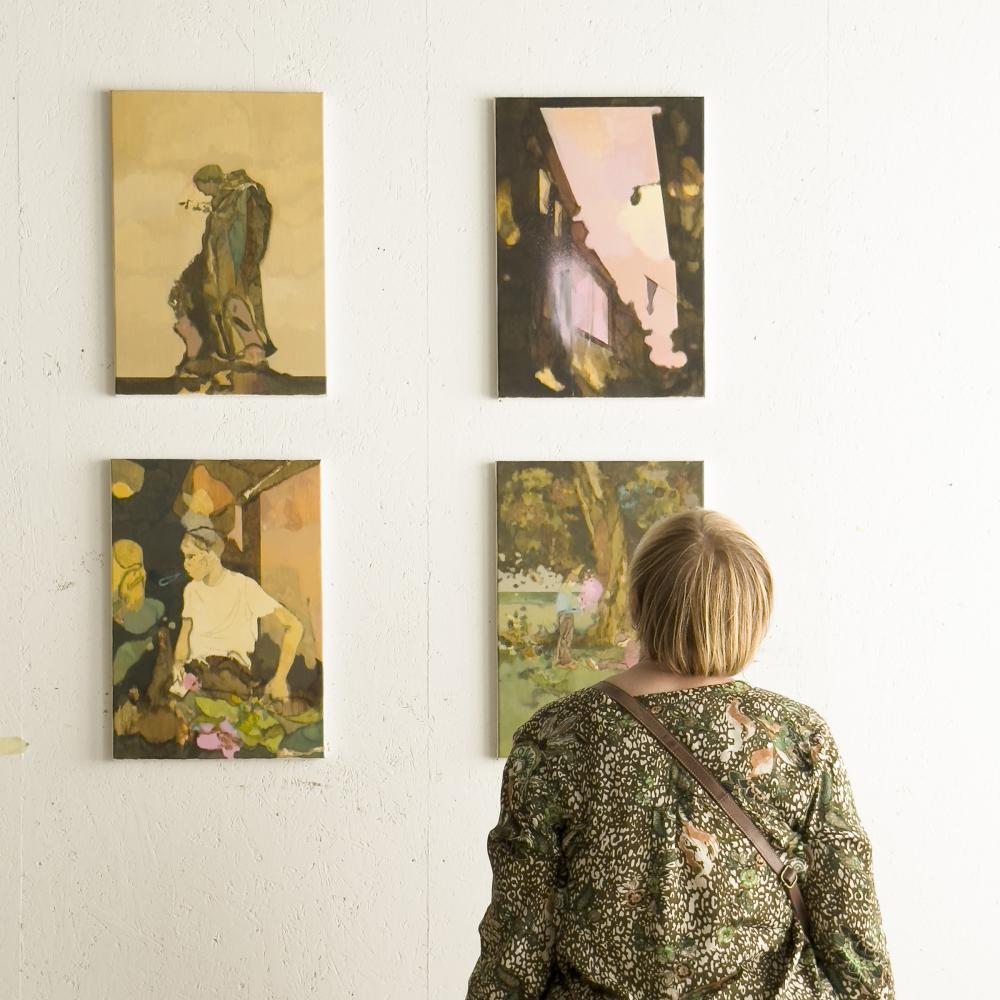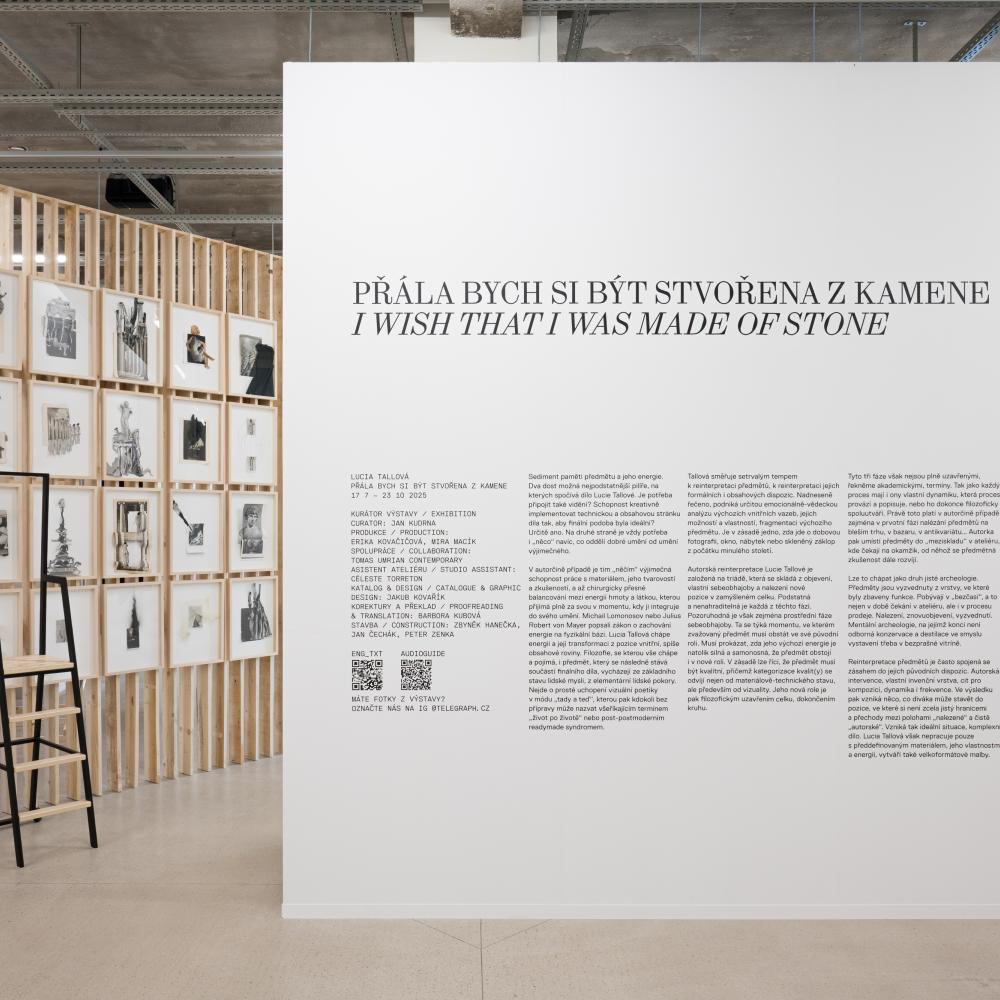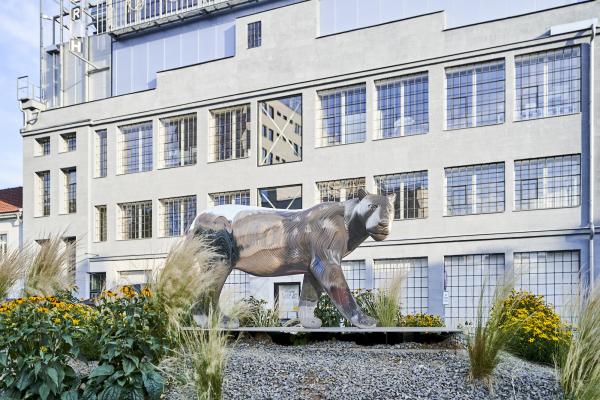
Michal Gabriel (*1960) is one of the most important postmodern sculptors on the domestic scene and the winner of the 1994 Jindřich Chalupecký Prize. Gabriel graduated from the Academy of Arts in Prague, where he co-founded the group Tvrdohlaví. Since 1997, he has been a teacher at the Faculty of Fine Arts of the Brno University of Technology, where he leads the Sculpture Studio 1. Around 2002, he founded a 3D studio, which was part of the studio until 2017. Then it became the 3D Technology Cabinet and now it operates independently under the direction of Tomáš Medek. Michal Gabriel's ambition is to establish a studio that would build on the 3D Technology Cabinet with a focus on virtual reality and an emphasis on its function as a sculptural tool, similar to the means used in the field of digital sculpture. Gabriel perceives sculpture as primarily physical, as a shape-invariant object with a great capacity to persist over time, but also as an idea. The main motifs of his works are flora and fauna. He places his works in spatial and architectural contexts and then explores how sculptures interact with their environment. He works with traditional materials such as bronze and wood, as well as less traditional materials such as polyester resin and stainless steel. For 3D prints, he uses ABS plastic, PLA or various polymers. He tries to look for new, novel structures that create a surface finish on realistic shapes to emphasize the fact that the material used is inseparable from the artwork. The sculpture thus literally grows out of the material. For an example of Michal Gabriel's work, visit the front of the Telegraph building to see a sculpture of a beast from a series of feline beasts that are meant to symbolize nature and its power. The sculpture is titled Mimicry.
You began to appear more prominently on the art scene in the collective generational exhibitions known as Confrontations. Can you tell us which ones you have participated in and which works, yours and those of other artists, have been on display?
Outside of Confrontation, which took place in Jiří David's studio in Smíchov, I participated in all of the following. I don't remember exactly all the works I exhibited there. Some of them no longer exist, but I have my first larger wooden sculpture from that time, called Egyptian. Another more significant sculpture that I remember, which is now in the collection of the Gallery of Modern Art in Hradec Kralove, is a sculpture called Three Dogs. I also have one of the three figures, which I once decided to remake after one of the confrontations. It is still unfinished and I still believe I will go back and finish it. I remember the works of the already mentioned Jiří David or Jaroslav Róna, Petr Nikl, František Skála, Martin Mainer, Stanislav Diviš, Milada Dočekalová and many others. However, I cannot describe their paintings and sculptures and assign them to individual Confrontations.
What do you see as the difference between exhibiting indoors and outside of a gallery setting? How do you choose the location for your sculptures? What kind of reactions to your works do you then encounter?
The gallery is a testing space to show details, shapes and ideas that a public space would cover and render invisible. The gallery space allows works to be juxtaposed in quantities that are impossible in a public space. The clean environment of the exhibition space allows for a focus on the ideas and energies contained in the individual works.
The public space is a reality - in it the work must stand and not disappear. In the case of a sculpture, half of its effect is created by the environment in which it is set. They interact with the environment of the landscape or square to develop a new visual narrative. At one time I was quite involved in finding landscapes for my sculptures and sculptures. I needed to see them in a non-painterly space and, at least in a photograph, preserve the landscape relationships and stories that emerged. In order to find the ideal location for the sculptures I chose, I drove around the landscape and imagined how they would look in it. One space had to be chosen, two at most, and close together. I booked transport and helpers to move them and arranged a date with the photographer. I always worked and still work with Ondrej Polák. The weather, if you are in the countryside all day, is always perfect at some point. We often set up the sculptures at dawn, waited for clouds, light, shadows and took pictures. Ondřej was mainly taking the photos and I was just doing test views, but mainly walking around the sculptures and feeling how they interacted with their surroundings. I enjoyed the one-day installation, in which there was no need to think about technical details related to, for example, firmly anchoring the sculptures into the ground. Later, I capitalized on the experience of the relationship between sculpture and landscape in long-term installations in public spaces. The same sculptures in a different space and placement transformed their story. The same bronze sculptures arranged on the beach in a 500-meter-long installation had a different effect than the same sculpture huddled in a circular group in, say, a town square. Linking the two sculptures then opens up another new story. The story of the sculptures unfolds on a visual, emotional and archetypal level. It is not politically topical, but it opens a window into a spiritual world obscured by a practical consumerist presence focused on economic growth. This is also how most sculptures are received by viewers. I am happy when people respond to my sculptures even though they do not comment or criticize the current situation in society. I don't want to provoke or be politically topical. I bring the present into the sculptures by referring to archetypal memory suppressed by the practical present but also by using unusual surface structures or new sculptural technologies. I think the viewers subconsciously and consciously perceive this and I cannot complain about their reactions.
What led you to choose wild beasts, sharks, birds of prey and the like?
Wild animals have always interested me. I see them as equal human contemporaries that are in many ways more perfect than humans. Their minds don't evolve as quickly, and so they haven't abandoned the wild way of life that we humans have. They are a present memory of the wild paradise we also lived in. I have chosen iconic predators in which we still admire with a little shudder the beautiful physique subordinated to perfect hunting. In the beginning it was a very intuitive choice and only gradually did I realize what I wanted to observe. During my studies, I started with the cheetah, a magnificent cat-like beast that is close to the canids. Later, I returned to the subject of the feline beast through abstract sculptures and structures. Through the structure on the surface of the sculpture, I approached the patches on the fur of leopards, jaguars and cheetahs. The structure composed of nutshells had other meanings for me. It disturbed the sculptural form or the author's modelling on the surface of the sculpture. It replaced the realistic details and filled in the shape outline of the sculpture. It resembled a natural growing structure and evoked the idea that the sculpture had no author but had grown into the shapes itself. Because of the structures, I decided to continue with more sculptures, but with the idea of giving more space to the realistic shapes. I made several more cat-like beasts in poses mistaken for real movement. None of the animals were in a leaping position, but instead in a steady slow walking motion. The positions kept increasing, but the possibilities are not endless, so I decided to end the variations with a sculpture composed of seven walking animals. I changed the view of the structure a little, which after being cast in bronze lost the natural appearance of the growing body of an exotic tree. I began to realize that the structure had another new level for me, one that works with the viewer's imagination and allows them to engage in the interpretation of the sculpture. The structure on top of the realistic shape outline of the sculpture created a projection surface for the viewer's idea of the details. Everyone has seen the feline beast, but everyone has decided which one. Someone saw leopards, someone saw jaguars, someone saw cheetahs. With that and the beasts, I modeled and mixed each of several big cats - leopard, jaguar cougar, lioness. I combined them into a pack, which often includes cheetahs. I was going for the archetype of the feline beast that we all have historically stored in our memories and that threatens us or we admire in our dreams. Later, I decided to go with another iconic bird of prey and created a flock of birds of prey standing on the ground. Again, I sculpted each sculpture to incorporate the shapes of eagles and vultures. I overlaid the shapes with structure and enclosed the flock in nine sculptures. I can't say that the sharks followed, as I was interested in them before the flock was formed. I was fascinated by the perfection of form combined with the functionality of the predator. This perfection rivaled even the intelligence of evolutionarily superior dolphins and other aquatic mammals. The school of sharks has not yet been matched in number and so far consists of five 250 cm long sculptures, one 300 cm long and three 500 cm long. Again, this is an archetype of a parabola drawing on the shapes of the most famous sharks. I would like to create sculptures of other wild animals as well, and I would like to achieve a way to combine them into a visual and meaningful large sculpture. They would be connected by surface texture and visuality. Whether they can be made into a sculptural story remains to be seen. Other animal sculptures are connected to people and their history. Along with the animals, I worked on thirteen sculptures of male figures, which I call players. I also cast three horses and a fourth with a rider in the same structure as the animals and also the players. Horses are a sculptural challenge that I gladly accepted, choosing the less domesticated breeds. I plan to connect the resulting sculpture, titled The Rider, with other sculptures that have the same structure on their surface.
How did you arrive at the concept with original structures such as acorn caps, peach pits, peanuts and walnuts? Do they have any hidden symbolism?
In the early 1990s I was creating smaller objects from natural materials and enclosing them in plexiglass boxes. In the Seven Days series, I placed a small sphere made of wax and acorn caps in one of the boxes. The sphere, with its structure made of acorn caps glued together with beeswax, really looked like some unknown plant fruit. This led me to the decision to create another larger object with a similar structure. I replaced the acorn caps with walnut shells and used the wax to glue together two smaller and one larger sculpture. I worked in a gradual layering process, like swallows building a nest. The sculptures grew into abstract shapes only roughly corrected by me and really looked like naturally growing structures. I wanted to have more control over the realistic shape, and this led to a change in process. I started to fold the structure into a casting mold. In this way I created the first animal, which was something between a cat and a dog. I shaped it still as a growing structure. From there I later moved to a realistic shape and created the first feline beasts. The similarity of the structure to the spots on their fur led me to do this. Gradually, intrigued by other naturals, I tried other possibilities for new structures. I worked with peanut and walnut shells, cut peach pits, acorn caps, black walnut shells and also eucalyptus fruits. The structures looked excellent, but were misleading to the decorative. But they are definitely completely original and you won't find any like them, even after a thorough search of the internet. This is also based on a technological process that I had protected by a patent. I could develop the structure further in this direction. In the end, I decided on just one or two variations that made sense to me in the context of sculptural shapes. I usually work with acorn caps encased in white polyester resin. The decorativeness, the too-fine texture when cast in bronze, and the impossibility of permanently installing these sculptures outdoors, led me to focus my attention on a structure composed of walnut shells. Gradually I cast most of the sculptures in this structure, and immediately after casting them in resin I began to cast the sculptures in bronze and exhibit them outdoors for a long time.
While you depict the fauna sculptures realistically, there are various deformations in the figurative sculptures. Why is that?
I usually model figurative sculptures realistically, but without naturalistic details. I enjoy hyperrealism, but I've never had the naturalistic detail to perfect it. Life-size sculptures of people with realistic proportions interest me. It's similar to animals. The collected postures and gestures start to develop their own stories hidden under the structure. The structure again becomes a projection surface of the viewer's ideas of details on the comprehensible spatial outlines of the figures. The characters connected by the structure, arranged in relational sculptures, are open to the viewer's interpretations. The viewer can perceive the sculptural narrative not only with his eyes, but also with his sense of touch. I like when viewers touch the sculptures. The structure cast in bronze is ideal for touch. The concept of the sculpture as a blurred shadow of an archetypal memory is still exciting to me. But the sculpture is also important to me in its unconcealed realism. Sometimes I try to reinforce its effect with a simple deformation, or I use the deformation to focus attention on a certain part of the sculpture. But I do this more with the sub-life version of large sculptures. This is also made possible by the ease with which it is possible to work with shape using the tools of digital sculpture. For example, in order to exhibit the sub-life figural sculptures without a plinth, I stretch the limbs of the sculptures so that the sculptures are at the viewer's eye level. Interestingly, the stretching approximates the proportions of Giacometti's figures. I'm talking about details that I don't leave on the sculptures, but that I see in the process of creating the sculpture. Without the precision of the computer they would not have been created and it would be impossible to see and compare them. But Giacometti was able to see them and process them without a computer. The possibilities to work with any shape using the tools of digital sculpture are enormous and I use them very sparingly. I realized that I needed to know the goal of the different shape treatments, that just playing is not enough. Very quickly the artist gets lost in it, as I myself experienced in the early days of working in 3D. The main thing I have come to, although it is not yet visible in the results for others, is an understanding of the importance of shapes separated from the material. One becomes aware of this separation when working with shapes in virtual space. Shapes are represented there as surfaces without internal matter and can be easily deformed in a way that would never be possible with a real shape carried by some material. But working with dematerialized shapes has to make clear sense, so I stick to the simplest options, which are deformations in one or at most two of the three spatial axes. To emphasize a certain viewpoint I use relief shortening or, as I mentioned before, to bring a small sculpture closer without using a plinth I use, on the contrary, elongation in the vertical axis. Shapes can just as easily be turned inside out and worked with in other incomprehensible ways, but then the results become rather rare and no one realizes the significance of such a gesture because in real life such a result is unknown, impossible and therefore unreadable. But this will change in time when the world of virtual shapes is made accessible by, for example, virtual reality. This is the direction in which I want to take the next step in Sculpture Studio 1.
In front of the Telegraph building is your sculpture Mimicry created using 3D technology. Is the sculpture one of your early works in this technology, or did you already know exactly how to use the program?
It is among the test sculptures, but not because I tried the program. I was already fairly proficient in the program by the time this sculpture was created. Basically, I used the layering principle that is typical of 3D printing - but in this this sculpture is not something new. It was preceded by about six large steel sculptures. On this sculpture I wanted to test how the shape would behave in a mirror-polished material. I took one of the animal sculptures from the Smecek sculpture, specifically the seventh animal. More specifically, I took a scan of this sculpture and gave it a larger dimension in the computer and cut it into 5mm thick layers. I sent only the head of the animal to production because the outcome was uncertain. When the head was made and I leaned over it and saw the flat mirror reflection of my face I understood that we had to finish the animal. The reflection of the surfaces on the animal's body gives a strange spatial illusion of the transition of the shape from the three-dimensional to the two-dimensional space of the mirrored surface. Technologically, this way of working is very demanding in some moments and I would not have been able to prepare the sculpture for production on my own. I cooperate in this direction with my son Michael Gabriel, who is able to solve the technical details related to cutting the slats and locking them in the right exact position. The steel slat sculptures came about after an offer from Kasper Kovo - the owner of the company Mr. Kasper asked me to create a sculpture from stainless steel sheets. I knew that steel plates are very demanding for any spatial shaping and therefore it is necessary to work with great simplicity of form - I was not very interested in this. I was thinking about how to get the shapes as controlled as possible in detail and proportional relationships and realised that this could be achieved by a principle commonly used in 3D printing. I began to see the steel sheets as layers of 3D printing and now all I had to do was "cut" the chosen sculpture virtually in layers. The choice of the direction of the layers in relation to the sculpture is an important artistic detail that gives the sculpture a dynamic or restful form, but can also greatly affect the static and strength of the sculpture. The floor plans of the respective sections are virtually redrawn into the layers and these layers are connected with arresting pins. The pins number in the tens of thousands and are designed to not penetrate the future surface of the sculpture, while accurately guiding the overlapping and interlocking shapes of the emerging sculpture. These plans are used to create cutting plans for the placement and numbering of each future cutout in the steel plate surfaces. However, this is already prepared by the company itself. Neither of these tasks can be done without the help of a computer and 3D programs. It looks complicated, it is complicated, and I am always surprised that the sculpture finally appears in the factory hall in the full weight and beauty of the material. It's always a miracle for me, but one that I can watch during its creation. Unlike classical sculptural processes and techniques, I cannot enter the ongoing process with any changes. The sculpture is unchanged from the completion of the 3D models and cutting plans.
Was it complicated for you to understand the new technology? After all, it's not exactly your field of study. And what does 3D printing bring to your work?
I wouldn't use the word understand, because when you see in 3D technology the tool and the possibilities it gives you, you have actually already understood it. I just perceived it through my industry, so it was just an extension of that. When you see the possibilities, you're not really learning. For a while in the beginning, it was maybe complicated to accept this new technology because it didn't make sense to me yet. It lacked the return from the virtual world back to the real world - 3D printers weren't available yet. But as soon as the opportunity presented itself, I didn't hesitate. That doesn't mean I'm some big expert on these 3D technologies. I just know what I want from them, what their capabilities are, and who to turn to when I need to solve a problem that is beyond me. I supply the ideas and thoughts myself, and these technologies are a great tool, but still just a tool. 3D printing is not the only way to get shapes out of a computer. On a larger scale, robotic machining helps us. But 3D printing has a strong position in detail. But I still realise how important it is to be able to help myself with sculptural modelling in complicated cases. I often do that, and I encourage students to do that as well. They need to be able to model in sculptural clay and they need to be able to cast the sculpted shapes in the traditional way. They can then combine these processes with the processes and outputs of digital sculpture.
What do you see as the difference when using digital technology? Do they make your work easier or more challenging? Has it happened to you that an imagined design could not be realized in the end using 3D printing?
As I described in the previous question. Traditional and digital technologies do not lie separately. The realization of a work naturally flows from traditional sculptural processes to digital ones and vice versa. It is always for the purpose of fulfilling the sculptural idea as simply and accurately as possible. But to answer the question, it hasn't happened to me that a design couldn't be realized in 3D printing. The design is always created in parallel with the technology in which I think about it. The most that could happen is that the design didn't turn out as I wanted or the print failed for technical reasons. However, it has often happened that I have continued to work with the resulting printing error and turned it into a sculpture with unrepeatable detail.
At the Faculty of Fine Arts in Brno you are the head of the Sculpture Studio. How do you transfer your knowledge and teach your students and what do you see as their interest?
I have a system of repetitive tasks for the first and second year, which all students go through. For example, in the first semester they do a sculptural self-portrait. They are also introduced to the tools of digital sculpture while they are working on it. They replace the photos they can work from in the self-portraits with 3D scans. They can freely shoot and view it on the monitor from views otherwise unavailable. They can also print out a scaled-down self-portrait and study the proportions from that as well. Other assignments cover the anatomy of the human body, drapery, and finally, students model a life-size figure after a live model. In all assignments, they can use 3D technology as an assistive tool. In the following semesters, I no longer assign them tasks, but instead expect them to discuss their topics, which I consult with them. I certainly don't teach them art, because I can't. I teach them the processes by which they can realise their intentions and I teach them how shapes can be looked at and worked with. Sometimes I get a lot of interest and that's empowering. If the interest in sculpture doesn't materialize or dissipates, the student usually finds another studio or drops out of school. But this is rather exceptional.
At the Gallery of Contemporary Art in Prostějov you have an exhibition together with your students and graduates. This is an exhibition that features works created with 3D technology. How did you come up with this exhibition concept? Does it often happen that you exhibit with your students?
I used to exhibit with my students more often. Now there are not so many opportunities, so I gladly accepted the offer to participate. The exhibition was arranged and selected by former studio student Emma Štěpánová and curator Mira Macík. I did not interfere in the selection of the works at all. There are not only works created with 3D technology, but also in the traditional way, and it is interesting for me that I am not actually aware of the difference between the works. That's a pretty good result, which I'm pleased about.
By Kateřina Kocourková, Inka Ličková / Telegraph Gallery
Portrait photo: Gallery of the City of Pilsen
